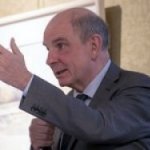De Universitaire Stichting organiseert tal van activiteiten voor de leden van de Club. In deze rubriek wordt verslag gegeven van voorbije activiteiten.
Zoals vorige jaren nodigden we onze leden uit op het VIP Weekend van het International Piano LAB for young artists onder de artistieke leiding van Liebrecht Vanbeckevoort, laureaat en favoriet van het publiek van de Koningin Elisabeth-wedstrijd voor Piano 2007, BAEF-Fellow en tevens lid van onze Club.
Voor meer informatie, klik "Read more".
Op dinsdag 24 juni 2025 om 17.30 u gaf Prof. Raymond Detrez (UGent) een causerie over Bulgarije onder de titel "Bulgarije - zwart schaap of paard van Troje in de Europese Unie." In deze causerie sprak hij over de vooroordelen over Bulgarije en de Balkan in het algemeen en over de huidige politieke situatie van Bulgarije in de EU. Deze causerie was interessant voor iedereen en een goede voorbereiding voor de deelnemers aan de reis in Bulgarije in september.
Causerie gevolgd door een hapje en een drankje.
Denis Van Weynbergh is de eerste Belg die de Vendée Globe heeft volbracht: hij voltooide de reis per zeilschip rond de wereld non-stop, zonder assistentie en alleen. Deze race wordt ook wel de Everest van de zeeën genoemd.
Met de prestatie van Denis Van Weynbergh willen we ons richten op het overstijgen van onszelf en onze grenzen, wat kenmerkend is voor topsporters.
Op woensdag 18 juni 2025 om 19 u heet Denis Van Weynbergh het verhaal van zijn reis gebracht in de Universitaire Stichting (in F).
Zijn verhaal werd gevolgd door een wetenschappelijk debat (N/F). De wetenschappelijke componenten werden ontwikkeld door Jos Verschueren (Postgraduaat Sportmanagement VUB) en Jean Michel De Waele (sportsocioloog ULB).
Het debat werd gevolgd door een "walking dinner".
Het is geleden sedert het Covid-tijdperk dat de Universitaire Stichting een opera aanbood. We eindigden het muzikale seizoen 24-25 op dinsdag 17 juni 2025 met de feestelijke uitvoering van de ophefmakende opera "Carmen" van Georges Bizet, voor het eerst opgevoerd 150 jaar geleden.
Op maandag 16 juni 2025 om 17.30 u. organiseerde de Universitaire Stichting een debat (N/F) over het begrotingsprobleem in België, met prof. Koen Geens (KU Leuven) als spreker. De spreekbeurt werd ingeleid door prof. Dirk Heremans (KU Leuven) en commentaar werd gegeven door prof. Eric De Keuleneer (ULB en Universitaire Stichting).
Prof. Koen Geens is emeritus gewoon hoogleraar (KULeuven), ere-advocaat aan de Balie van Brussel en oud-minister van Financiën, Justitie en Europese zaken.
foto: Robert Boons.
In korte tijd ziet onze wereld er helemaal anders uit. Ook Europa ondergaat de nodige evoluties. Op dinsdag 3 juni 2025 om 18 uur kwam prof. Hendrik Vos (UGent) zijn visie uiteenzetten in een lezing: De Europese Unie, een geschiedenis (en hoe die haar schaduw werpt over vandaag en morgen).
De lezing ging door in het Nederlands. Moderator en discussiant was ambassadeur Pol De Witte, directeur-generaal van het Egmont – Koninklijk Instituut voor Internationale Betrekkingen (N/F). Nadien volgde een debat.
Nadien werd een hapje en drankje aangeboden.
We bieden onze leden graag goede plaatsen aan voor aantal abonnementen en losse tickets voor de Koningin Elisabethwedstrijd 2025 voor piano in BOZAR.
Tweede lezing over Japan, met als titel "Debunking the Myth of a Homogenous Society: Diversity in Modern Japan?" op dinsdag 1 april om 17:30 door Prof. Andreas Niehaus (UGent). Interessant voor iedereen, maar een goede voorbereiding op de reis naar Japan.
Lezing gevolgd door een hapje en een drankje.
Donderdag 27 maart 2025 om 18u: lezing « Les doctorats honoris causa attribués au Général de Gaulle en 1945 » met Jean-Paul Sculier (médecin, professeur émérite à la Faculté de Médecine de l’Université Libre de Bruxelles) en Michel Willem (ingénieur civil, professeur émérite à l’Université catholique de Louvain) (enkel in het F) – gevolgd door een hapje en een drankje.
Woensdag 19 maart om 17.30 u.: Een lezing (N/F) over Japan met als titel "Alles is relatief, ook Japan" wordt gehouden door Professor Willy Vande Walle (KULeuven). Deze lezing was een goede voobereiding op de Japan-reis van de Universitaire Stichting, maar voor idereen interessant.










